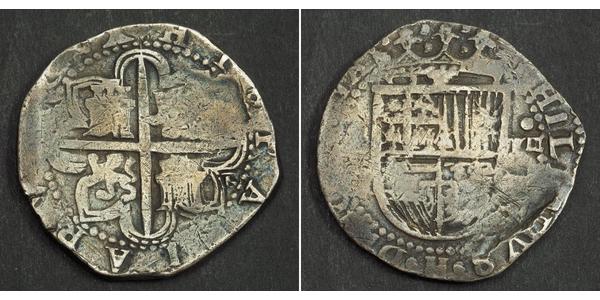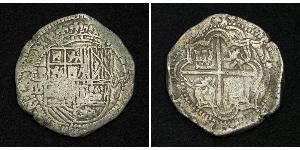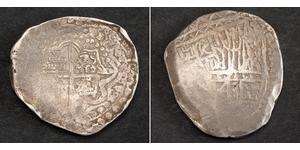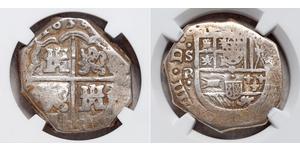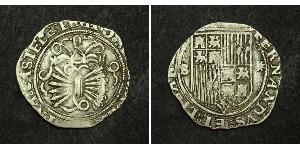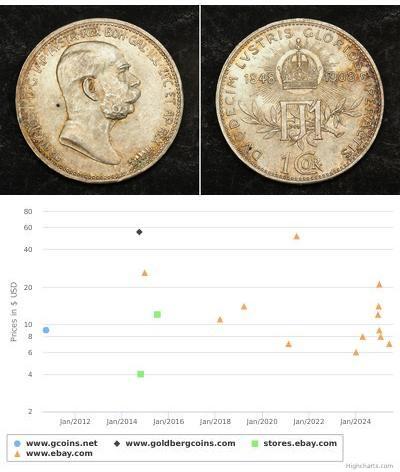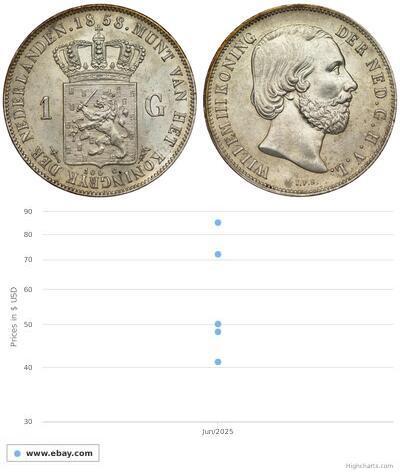(sold for $261.0)
1598, Kingdom of Spain, Philip II. Large Silver 8 Reales Cob Coin. Seville mint!
Mint Place: Seville (S) Mint Period: 1556-1598 Assayer Mark: Gothic D. Reference: CT-235 (page 184), KM-. R! Denomination: Cob of 4 Reales (Half Piece of Eight!) Condition: Dakly toned, with some marks on edge (possibly removed from a suspension) and a few scratches, otheriwse about VF! Weight: 27.16gm Diameter: 38mm Material: Silver
Reverse: Cross of Jerusalem with lions and castles in quarters. All within 8-foil tressure. Comment: Assayer letter (gothic D) placed at 4 o'clock between tressure and pelleted-border. Legend: + . HISPANIARVM . REX .
Reverse: Crowned shield with royal arms. Mint initial (probably S, considering the type, but not really visible) in left field, value (oVIII) in right field. Legend: PHILIPPVS ° II ° DEI ° GRATIA
The first coinage of the New World and what comes to mind when we think of Pirate Treasure are pieces of eight. These first coins, often called cob coins, were made from roughly cut planchets (blanks) by striking them with hand dies. The word Cobb comes from a simplification of the Spanish phrase, Cabo de Barra, which translates as, from a bar. After the coins are struck, they are weighed by an assayer who cuts off any excess Silver which is why most coins have some of the impression cut away. Due to this method of manufacturer no two coins are alike and many are collected for their unique shapes alone. The Cobb coin, like anything that is no longer available is becoming very scarce and hence more valuable. The few remaining Coins are the last vintage of the glory days of pirates and Treasure hunting and are fast disappearing into private hands.
Philip II, King of Spain 1556-1598. Son of Emperor Charles V (King Charles I of Spain), founder of the Spanish line of Habsburg. * 1527 Valladolid, †1598 Escorial near Madrid. Philip II received from his father the following contries: in 1540 the Duchy of Milan, in 1554 the Kingdoms of Naples and Sicily and in 1555/56 the Netherlands, the Franche-Comté and Spain with its colonies. In 1580 Philip also claimed and took over Portugal. He strove for Spanish world supremacy and fought for the counter-reformation. He was married four times: Maria of Portugal (*1526, †1545 following the birth of Don Carlos), Queen Mary Tudor of England (1554, †1558), Elizabeth of Valois, daughter of King Henry II of France (1559, †1568) and finally, in 1570, Anna of Austria, daughter of Emperor Maximilian II. King Philip II fought successfully against France (1557-1559), against the Turks (Juan d'Austria's victory near Lepanto in 1571) and against Mediterranean pirates. However, his attempt to conquer England failed (destruction of the Armada in 1588, sea-battle of Cádiz in 1596), as did his efforts to subdue the revolting Netherlands (secession of the northern provinces). Philip's ongoing war efforts overstrained his financial and economic resources and eventually led to the decline of Spanish supremacy.

|
Posted by:
anonymous 2019-09-18 |

